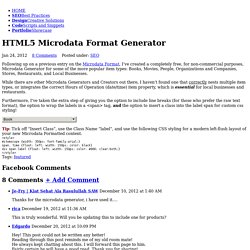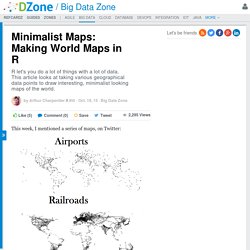

3D Models for free. Introduction. HTML+RDFa 1.1 - Second Edition. A.1 History This section is non-normative.

In early 2004, Mark Birbeck published a document named "RDF in XHTML" via the XHTML2 Working Group wherein he laid the groundwork for what would eventually become RDFa (The Resource Description Framework in Attributes). In 2006, the work was co-sponsored by the Semantic Web Deployment Working Group, which began to formalize a technology to express semantic data in XHTML. This technology was successfully developed and reached consensus at the W3C, later published as an official W3C Recommendation. HTML5 Microdata Format Generator. Following up on a previous entry on the Microdata Format, I’ve created a completely free, for non-commercial purposes, Microdata Generator for some of the more popular item types: Books, Movies, People, Organizations and Companies, Stores, Restaurants, and Local Businesses.

While there are other Microdata Generators and Creators out there, I haven’t found one that correctly nests multiple item types, or integrates the correct Hours of Operation (date/time) item property, which is essential for local businesses and restaurants. Furthermore, I’ve taken the extra step of giving you the option to include line breaks (for those who prefer the raw text format), the option to wrap the labels in a <span> tag, and the option to insert a class into the label span for custom css styling! Generate Rich Snippets Easily. Schema Creator.
ActiveTextbook. Injectez du multimedia dans vos pdf. ActiveTextbook est un outil TICE en ligne qui permet d’insérer des éléments multimédia interactifs dans un PDF.

ActiveTextbook propose par ailleurs un lecteur en ligne qui va permettre à vos élèves ou vos lecteurs de commenter et de discuter le document PDF partagé. Un outil qui peut trouver toute sa place dans vos échanges avec une classe ou des étudiants. L’idée de départ des concepteurs est de vous proposer d’uploader un PDF sur la plateforme pour pouvoir l’enrichir simplement d’éléments multimédias avant de la partager. Une fois uploadé sur la plateforme dans votre compte personnel, vous allez le plus facilement du monde pouvoir ajouter au document des images, des liens et des vidéos que les étudiants pourront voir lorsqu’ils consulteront le PDF avec le lecteur fourni par l’application.
D’un clic ils pourront lancer une vidéo ou suivre un lien que vous aurez au préalable inséré dans le doc. Dans la classe. Une version gratuite est proposée pour vous permettre de tester le service. Storytelling With Data: Visualize Simply And Focus Obsessively. Why We Hate Infographics (And Why You Should) Those 2 guys invented the spreadsheet with Visicalc.

I worship them for that. In 1989, during my first internship (don’t even dare asking), I discovered and toyed for days with a mind-blowing machine: an plotting table. It was like a printer, except that it was moving a dozen of color pencils over the paper, and it was meant to draw… graphs, as it was called in the 80′s. Then in the early 90′s, hipsters of that time decided that graphs weren’t cool enough, and called them charts. On an unrelated note, charts started being printed on regular printers, and boredom killed millions of interns. Then in the mid-00′s, the art of plotting/graphing/charting data was re-named… data visualization. This week, I mentioned a series of maps, on Twitter: some minimalist maps (poke @visionscarto) pic.twitter.com/Ip9Tylsbkv — Arthur Charpentier (@freakonometrics) September 2, 2015 Friday evening, just before leaving the office to pick-up the kids after their first week back in class, Matthew Champion (aka @matthewchampion) sent me an email, asking for more details.

He wanted to know if I did produce those graphs, and if he could mention then, in a post. Steganography. MASHER - create a video online for free. Blabberize.com - Got a picture? Blabberize it! Content Templates to the Rescue. 7 Simple Deep Linking Tactics You Ought to Use. Most people who work on the web…whether they are veteran SEOs or web content strategists…know about deep linking.

They understand that it is all about linking internal pages. You link internal pages to other internal pages…and you get other sites to link to these internal pages But few of them actually understand the advanced tactics of deep linking that reduce visitor bounce rate while improving page views, time on site and even subscriber numbers. If you’d like to learn more about the importance of deep linking, deep linking tactics and when you should avoid deep linking…keep reading.
Let’s do a quick little inbound link audit on your site. Before we get started, here’s a test. Hit enter and then click on the “Top Pages” tab: And then calculate the number of inbound links to your home page versus inbound links to all other pages on your site. What that means is people are not hitting internal pages.
In fact, the higher you can get that ratio, the better. 3 reasons why you should deep link.